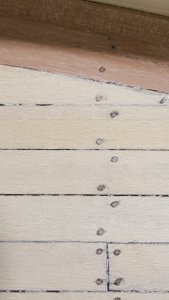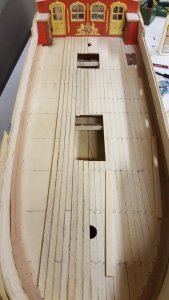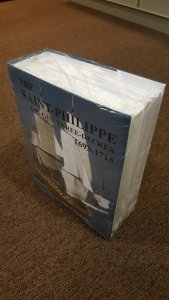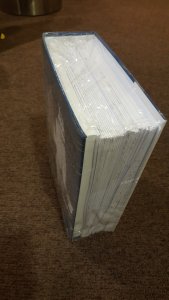Different oil on the same wood surface may give you various results. I use steel wool (0000, 4 zeros) and rub between the oil coats. However, you are correct! The only ways to know for sure - is to try.I will make two test pieces, one with oil and one with shellac french polished.
-

Win a Free Custom Engraved Brass Coin!!!
As a way to introduce our brass coins to the community, we will raffle off a free coin during the month of August. Follow link ABOVE for instructions for entering.
You are using an out of date browser. It may not display this or other websites correctly.
You should upgrade or use an alternative browser.
You should upgrade or use an alternative browser.
HMS Royal Caroline kit ZHL 1/30
- Thread starter Maarten
- Start date
- Watchers 112
-
- Tags
- royal caroline zhl
A brief update on my deck progress. The deck is half finished with planking. Now it is time fore treenailing this part. Same as for the hull I use beech wood toothpicks. The holes drilled at 0.7mm followed by colouring the edges of the holes with a 2B pencil.
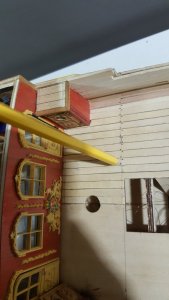
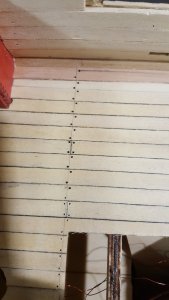
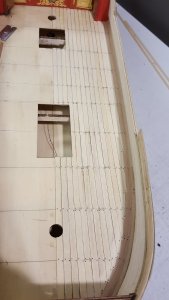
Now glueing the toothpicks, for this I use a very small droplet of ca.
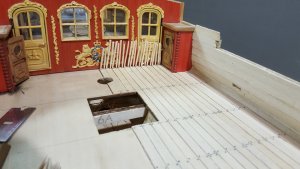
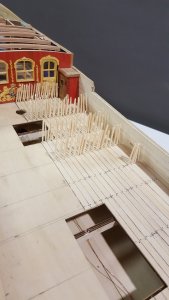
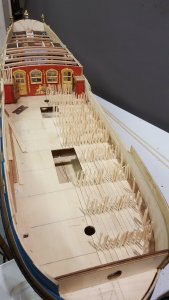
Then after the ca is dry I cut the with a nose cutting plier. Followed by sanding and scraping. Finall finish I do when the other half is also finished.
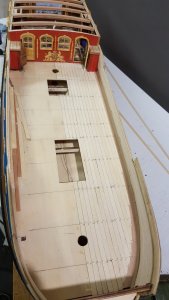
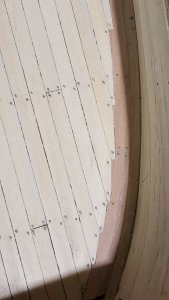
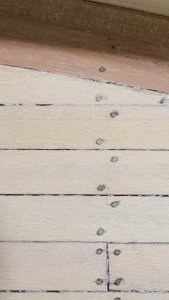
Thats it for now.
Start on the second half.
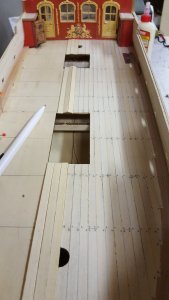



Now glueing the toothpicks, for this I use a very small droplet of ca.



Then after the ca is dry I cut the with a nose cutting plier. Followed by sanding and scraping. Finall finish I do when the other half is also finished.



Thats it for now.
Start on the second half.

All I can say is that here is a perfect example of what experience can do for a build! You have had mentioned CA uses for toothpicks. How is the wood reacts? Will glue soak into the wood and leave clogged surface? I can assume that graphite will hold the glue to the deck planks, but how about the actual treenail (toothpick)?
Hi Jim,
I use a thick ca to avoid it to soak fully into the tooth pick. See picture zoomed in below for the result, no clogging appears allthough the wood is becoming slightly darker. I have considered to use titebond but I was happy with the ca result in combination with the graphite and it works quick and clean.
When using a marker instead of graphite then the ca will dilute the marker and spoil the surface.
I use a thick ca to avoid it to soak fully into the tooth pick. See picture zoomed in below for the result, no clogging appears allthough the wood is becoming slightly darker. I have considered to use titebond but I was happy with the ca result in combination with the graphite and it works quick and clean.
When using a marker instead of graphite then the ca will dilute the marker and spoil the surface.
Great, Thank you! I thought of the same answer. Appreciate your prompt answer.When using a marker instead of graphite then the ca will dilute the marker and spoil the surface.
Nicccccccccccccccccccce!! I guess you kinda reveal your next project?And today I received my book from Ancre, so new reading material for Christmas.
Hi Denis,Hi Maarten
Like your treenailing.
That is some book that will take you to next Christmas to read.
Denis.
Thx for your comments.
The book is only 200 pages, the rest is 42 drawings in 1:48 to build the ship.
Yes, I am considering that. Would be a hudge model in 1:48 scale. Hull size of 130 cm without rigging. Nice for detailing and a project for some 10 yearsNicccccccccccccccccccce!! I guess you kinda reveal your next project?
I am also expecting my copy these days - and will make a Planset review during christmas and new year
two minutes after I wrote this .... the postman was ringing at the door! Just received itI am also expecting my copy these days - and will make a Planset review during christmas and new year

G'day Maarten
I'm catching up on your log only after a week or so and wow, I have missed a huge amount. All I can say:
I'm planning to do the standard way that I always do my planking, which is different from yours in a few ways.
The first is that I going to put a king plank running down the centre of the RC.
The next thing that I found best is to curve the planking along and to follow the waterways up to a certain point where is is impossible to bend the plank any further. Then I'll do something like the following diagramme.
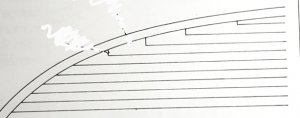
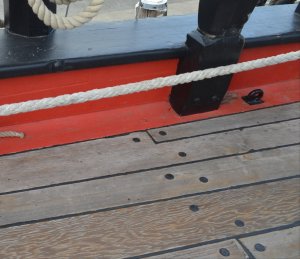
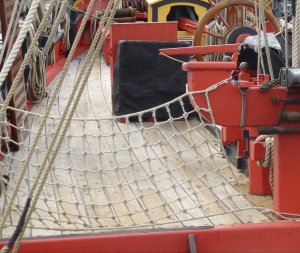
Note the curvature of the plankings
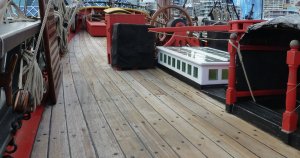
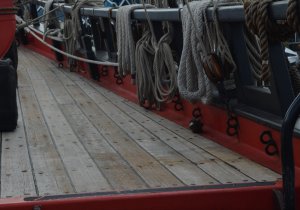
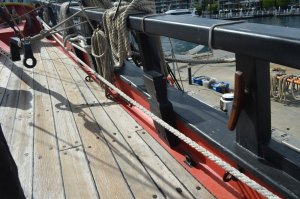
I really don't know which method are correct, but as I have said before, this is my standard deck planking method and the results looks good.
Sorry to take over your log mate.
I'm catching up on your log only after a week or so and wow, I have missed a huge amount. All I can say:
Another example of esquith craftsmanship.
The way you have done your planking is, or will be, why each modeler's methods make his build unique from others.I'm planning to do the standard way that I always do my planking, which is different from yours in a few ways.
The first is that I going to put a king plank running down the centre of the RC.
The next thing that I found best is to curve the planking along and to follow the waterways up to a certain point where is is impossible to bend the plank any further. Then I'll do something like the following diagramme.

The best way to explain my method is to show you the planking on the
HMB ENDEAVOUR
HMB ENDEAVOUR


Note the curvature of the plankings



I really don't know which method are correct, but as I have said before, this is my standard deck planking method and the results looks good.
Sorry to take over your log mate.
Great reference photos of Endeavour Greg. Thanks for sharing.
Maarten, your planking is excellent my friend.
Maarten, your planking is excellent my friend.
Hi Greg,
Many thx for your example which looks great. For the time period both options could have been used. A kings plank would look great but I cant confirm that these were already in use in the first half of the 18th century, maybe Uwe has some reference on this.
I love the curved planks but I think this will be difficult to realize as this main deck is veneer and veneer is difficult to bend around a horizontal radius as it then will create a bubbled surface.
This is why I selected the joggling into the margin plank. Choices choices choices .
.
Many thx for your example which looks great. For the time period both options could have been used. A kings plank would look great but I cant confirm that these were already in use in the first half of the 18th century, maybe Uwe has some reference on this.
I love the curved planks but I think this will be difficult to realize as this main deck is veneer and veneer is difficult to bend around a horizontal radius as it then will create a bubbled surface.
This is why I selected the joggling into the margin plank. Choices choices choices
I have done bending venee around a slight bend on the past and the result are quite good. The only time consuming part is the bruising the venee only on one side to make it bend easier.Hi Greg,
Many thx for your example which looks great. For the time period both options could have been used. A kings plank would look great but I cant confirm that these were already in use in the first half of the 18th century, maybe Uwe has some reference on this.
I love the curved planks but I think this will be difficult to realize as this main deck is veneer and veneer is difficult to bend around a horizontal radius as it then will create a bubbled surface.
This is why I selected the joggling into the margin plank. Choices choices choices.
That is why I stated in my previous log that I do it up to a point where it's impossible to bend any more.
The only trouble is that you waste a lot of planks trying to bruise them. Too much the plank will break, not enough, it wouldn't bend.
You are correct when you say choices, choices, choices!
Today I finalized the deck. First the second half was planked.
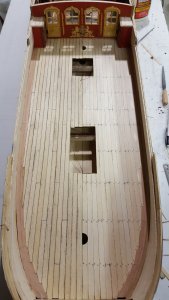
Followed by treenailing, scraping and sanding.
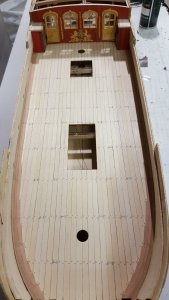
After all this finishing I decided not to go for shellac but as advised by @Jimsky for an oil finish. I already used this for the floor in the Kings dayroom and the surface is matt so OK to use on the deck.
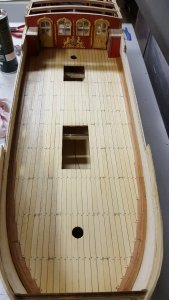
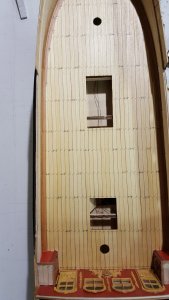
This is the oil I use, it is a monocoat parquet floor oil.
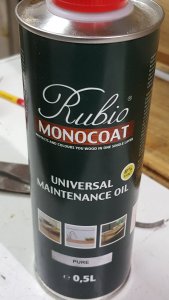
With this you create a beautiful rich colour and keep the wood structure and poures clearly visible.
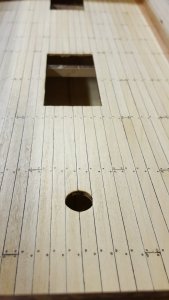
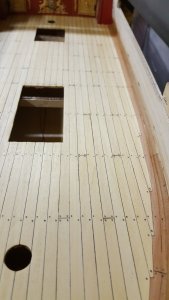
This is the end result of the treenailing zoomed in.
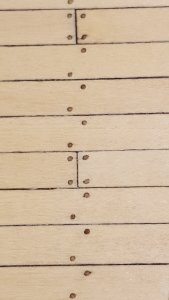
Now is is time for sanding the oiled deck with steel wool before applying a second layer.
To all a fantastic new year in good health and lots of happy modeling hours.

Followed by treenailing, scraping and sanding.

After all this finishing I decided not to go for shellac but as advised by @Jimsky for an oil finish. I already used this for the floor in the Kings dayroom and the surface is matt so OK to use on the deck.


This is the oil I use, it is a monocoat parquet floor oil.

With this you create a beautiful rich colour and keep the wood structure and poures clearly visible.


This is the end result of the treenailing zoomed in.

Now is is time for sanding the oiled deck with steel wool before applying a second layer.
To all a fantastic new year in good health and lots of happy modeling hours.
Excellent deck work, Maarten! I like the contrast between Pear (dark) waterways and light deck planks, and obviously treenails.
To all readers of this excellent build log wishing wonderful New Year and Happy Modeling!
To all readers of this excellent build log wishing wonderful New Year and Happy Modeling!

G'day Maarten
What more can I say again rather then brilliant work.......humm
HappyNewYear to everyone and havagoodone
What more can I say again rather then brilliant work.......humm
Marvellousticbrilliant work!......again.
The oil looks so great thanks Jim for showing us.HappyNewYear to everyone and havagoodone
Last edited:



